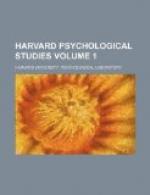Several points of comparison between judgments made with binocular and with monocular vision remain to be stated. In general, the process of location is more uncertain when one eye only is used than when both are employed, but this loss in accuracy is very slight and in many cases disappears. The loss in accuracy is perhaps also indicated by the range of variation in the two cases, its limits being for binocular vision +46’.29 to -56’.70, and for monocular +62’.30 to -61’.10, an increase of 20’.41. In the darkened room similar relations are presented. The mean variations are as follows: binocular vision, 31’.42; monocular, 32’.17. Its limits in individual judgments are: binocular, -1’.62 to -128’.70, monocular, +66’.38 to -71’.06, an increase of 10’.36. In all ways, then, the difference in accuracy between the two forms of judgment is extremely small, and the conclusion may be drawn that those significant factors of judgment which are independent of the figuration of the visual field are not connected with the stereoscopic functioning of the two eyes, but such as are afforded by adjustment in the single eye and its results.
VI.
The experimental conditions were next complicated by the introduction of abnormal positions of the eyes, head and whole body. The results of tipping the chin sharply upward or downward and keeping it so fixed during the process of location are given in the following table, which is complete for only three observers:
TABLE VIII.
Observer. Upward Rotation. Downward Rotation. C.E. A.D. M.V. C.E. A.D. M.V. L (50) +43.98 43.98 5.62 +28.32 28.32 5.02 K (50) -33.72 33.72 71.33 +19.49 19.49 55.22 L (20) -39.10 45.90 33.60 -68.65 69.25 25.20 Average: — 9.61 41.20 36.85 -19.94 39.02 28.48 Normal: -64.14 67.08 33.51
The results of rotating the whole body backward through forty-five and ninety degrees are given in the following table:




